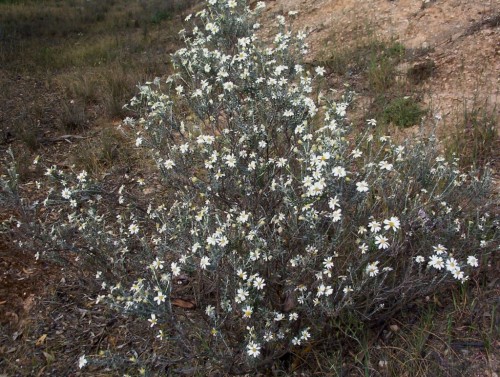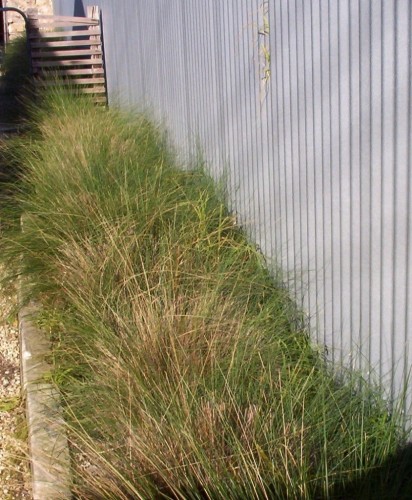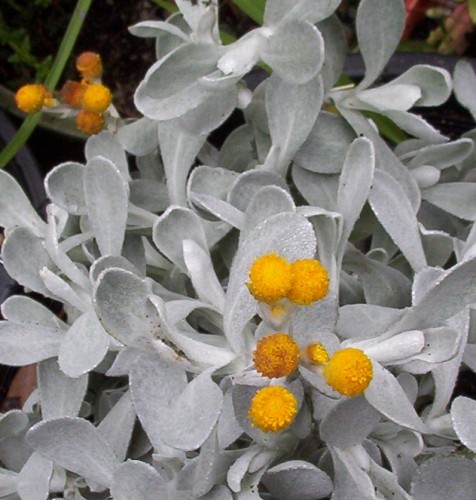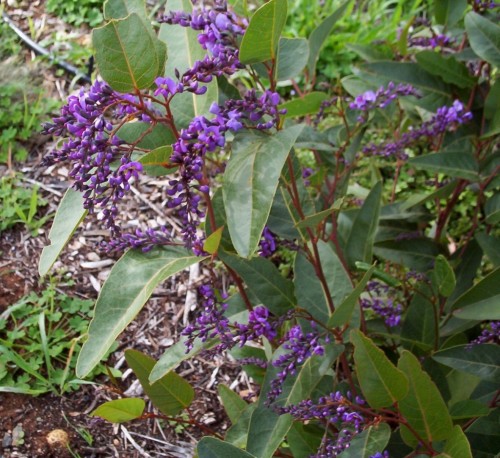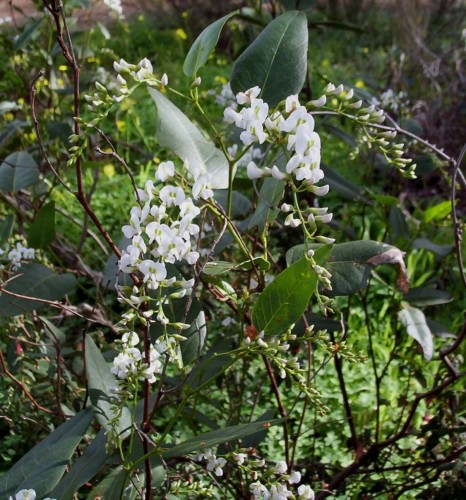Olearia pimelioides (Showy Daisy Bush)
This daisy grows to about 1 metre high and wide. It begins flowering at the end of winter into spring and makes a wonderful show. It grows in most soils particularly limey soils which occur around our place. Although the books say it is used commonly as a garden plant I have not found this to be so. To have 2 or 3 of them in a group would make the most wonderful spring display in a garden.
Grasses in the Garden
Although I would like to have some colour in the bed, the grass worked well because of the narrow space available. It can be tidied up after flowering, particularly important with native grasses that set seeds which can be a pest. The number of times I have had to ‘deprickle’ socks and fleecy jumpers or pants. When the seed begins to loosen in the panicle is a good time to get rid of the seed head to avoid having them become a nuisance in that way.
Chrysocephalum apiculatum
These plants need tidying up when new growth begins at the base of the plants.
My favourites have grey/green leaves and one has distinctly grey leaves. Of course the flowers look great against these leaves. The mallee form is a small clumping plant, with smaller flowers and green leaves. It is a dainty plant compared to the brashness of the others.
Hardenbergia violacea (Native Wisteria)
Top 5 Drought Tolerant Australian Native Plants…
…in five categories.
I decided that I would set 5 simple categories of plants and list five species within those categories.
Drought Tolerance is relative and what I have chosen are plants that are drought tolerant in an area with less than 14 inches (350mm) of annual rainfall (winter wet). Other issues which can make a difference are severe frosts, drying winds, the amount of rainfall the previous winter and whether mulch is used or the amount of shade available.
Ground Covering Plants
- Hardenbergia violacea (purple, pink, white) Native wisteria (Also a climbing plant)
- Chrysocephalum apiculatum (suckering plant with small yellow pom pom heads.
- Kennedia prostrata (Running Postman – because of red and black flowers and very flat form.
- Eremophila glabra (Emu Bush) (various prostrate forms, different colours)
- Myoporum parvifolium vigorous flat ground cover with white flowers
Small Shrubs to 1 metre
- Eremophila macdonnellii (large deep purple flowers)
- Eremophila macdonnellii (large deep purple flowers)
- Prostanthera magnifica (Mint Bush with very large flowers)
- Thryptomene saxicola (Pink or white small flowers)
- Grevillea lavandulacea
Tufted Plants
- Dianella revoluta (Purple nodding flowers and purple berries)
- Orthrosanthos multiflorus (Native Iris) (Mauve Blue flowers)
- Wahlenbergia communis (native Bluebell) (perrenial with blue star flowers.)
- Calostemma purpureum (Native Lily) (Pink-red flowers)
- Anigozanthos flavidus (Kangaroo paw)
Shrubs to 3 metres
- Acacia drummondii (yellow rods)
- Banksia ornata
- Melaleuca wilsonii (red bottle brush flowers)
- Chamelaucium uncinatum (various colour forms)
- Hakea leucoptera (Honey Suckle) (Prickly bush with cream flowers)
Trees
- Eucalyptus campaspe
- Melia azedarach (White Cedar)
- Callistemon viminalis (Weeping Bottlebrush)
- Agonis flexuosa (Native Willow)
- Melaleuca lanceolata (White bottle brush flowers)
These are some of my favourite plants and ones that I know to be successful. These are all growing in garden conditions. Growing the same plants in the field is another matter altogether and another list would need to be generated.
I haven’t been able to get to my blog for several weeks and this opportunity to participate in the latest Problogger writing project provided me with the push to get going again.

